Stéphanie Di Giusto The Dancer Interview
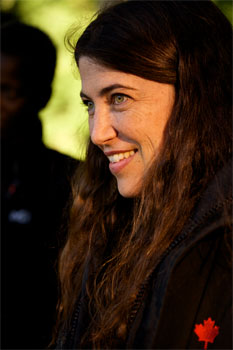
Stéphanie Di Giusto The Dancer Interview
Cast: Soko, Lily-Rose Depp, Gaspard Ulliel, Mélanie Thierry, Louis-Do de Lencquesaing, François DamiensDirector: Stéphanie Di Giusto
Rated: M
Running Time: 112 minutes
Synopsis: Born in the American Midwest, nothing in her background destined farm girl Loïe Fuller to become the toast of Europe's
Belle Epoque cabarets, even less to dance at the Paris Opera.
Hidden behind metres of silk, her arms extended by long wooden rods, Loïe reinvents her body on stage and enthralls her audiences a little more every night with her revolutionary Serpentine dance.
Dazzling the capital, she becomes an icon, the blazing symbol of a generation. Eminent admirers fall at her feet: Toulouse-Lautrec, the Lumière Brothers, Rodin. Even if the physical effort risks destroying her back, even if the glare of the stage lights sears her eyes, she will never falter in the quest to perfect her art. But her meeting with Isadora Duncan – a young prodigy hungry for glory – will lead to the downfall of this icon of the early 20th century…
The remarkable destiny of a modern woman who revolutionised her era.
The Dancer
Release Date: September 28th, 2017
Trailer
www.palacefilms.com.au/thedancer/
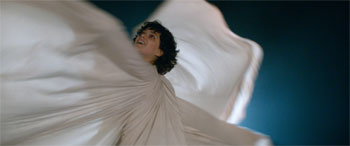 Interview with Stéphanie Di Giusto
Interview with Stéphanie Di Giusto
Question: How did the film come about?
Stéphanie Di Giusto: It all began with a black and white photograph of a dancer hidden in swirling veils and floating above ground with a caption at the bottom: 'Loïe Fuller: icon of the Belle Epoque." I was curious about the woman behind the long swathes of fabric, and her story blew me away. I loved the fact that she became famous by concealing herself, her trailblazing nature. With her Serpentine Dance, Loïe Fuller literally revolutionised the stage arts at the end of the 19th century. Yet no one, or almost no one, remembers her.
Question: What made you suddenly decide to embark on the adventure of a first feature film?
Stéphanie Di Giusto: I'd been passionate about film for a long time but striving for the level of the directors I admire seemed too daunting a task. My encounter with Loïe disinhibited me in a way. The struggle of this farm girl from the American Midwest for recognition as an artist gave me the courage.
Question: What was it about her that particularly touched you?
Stéphanie Di Giusto: She didn't possess any of the ideals of beauty that were fashionable in her day. She was physically unattractive. She had the strong, sturdy build of a farm girl and felt like a prisoner in a body she'd rather forget. Yet instinctively, she invented a move that would carry her across the world. The natural grace that she was lacking, she was able to create for her show, and thereby find liberation through her art. She would reinvent her body on stage. That's a hugely important notion for me. Some people find the words to communicate. She found a gesture and took hold of her destiny. She turned her inhibitions into movement, her uneasiness into energy, a wildly defiant explosion of life. I also wanted to capture the emotion of the struggle. It's a strange blend of strength, willpower and fragility.
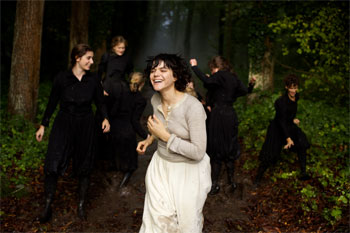 Question: From the start, you show her reciting classical texts and sketching in the middle of the countryside…
Question: From the start, you show her reciting classical texts and sketching in the middle of the countryside…
Stéphanie Di Giusto: She was an artist before becoming an actress. For her, art was a form of escape. Loïe doesn't like herself, but she's drawn to the beauty around her and only wishes to be an actress for the love of beautiful texts. She has no desire to display herself.
Question: The irony of destiny: her first role is a silent one.
Stéphanie Di Giusto: Yes, and from there on, she chooses to keep quiet and act. She only expresses herself in the dance movement she creates and that she constantly seeks to amplify. She takes off, literally, grabbing hold of her destiny and allowing herself to be carried by her faith in beauty and her own originality. Her passion knows no limits. It's a sort of race against time that brings her all the way to the Paris Opera. It's amazing that Loïe Fuller was able to gain recognition for her ballets. It goes to show how open the times were to creativity.
Question: The dance she developed calls on a great number of scientific disciplines: maths, chemistry, and stagecraft…
Stéphanie Di Giusto: Making her dance costume, which required 350 meters of silk, was a feat in itself. I didn't invent a thing by showing the mathematical formula used to create it. From the time of the first performance of her Serpentine Dance in the United States, in a cheap cotton dress, Loïe knew she'd need to find the means to illuminate and give it more volume, and that ordinary lighting effects wouldn't do the trick.
Loïe Fuller learned from every book she could get her hands on and everyone she met, including Edison and Flammarion the astronomer. She studied light and perfectly mastered stage lighting"hence her insistence on the need for 25 technicians"and even invented the phosphorescent salts she applied to her costumes, setting up her own chemistry lab. She's really at the foundation of abstraction and the multimedia arts. By the time she performed at the Folies Bergère, she was practically CEO of a company.
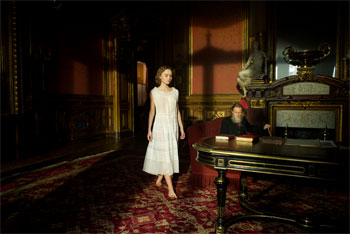 Question: She'd only just discovered her movement when it occurred to her to patent it.
Question: She'd only just discovered her movement when it occurred to her to patent it.
Stéphanie Di Giusto: She was also avant-garde in that respect. When she realized that patents didn't cover her field in America, her first reflex was to come to France where, she thought, her work would be recognised and protected. She was able to deposit ten patents in her name.
Question: Paris, followed by the rest of the world, did recognize her talent, but she was supplanted by Isadora Duncan.
Stéphanie Di Giusto: Isadora Duncan was the incarnation of all Loïe was not: youth, brilliance and grace. She's The Dancer. Isadora need only make an appearance whereas Loïe worked hard for hours on end and relied on a thousand artifices. I was intrigued by this form of injustice. We are all confronted by our limits, one day or another.
Question: How did you go about writing the film?
Stéphanie Di Giusto: At first, I worked on it as I would a documentary. I read a lot of books about her and met a lot of people, including Jodie Sperling, the dancer who best dances Loïe Fuller today, and whose help was decisive. Then I made her my own in order to express what it was about her that resonated with me. I wanted to get as close as possible to my heroine, to film her body, in an effort to portray the exceptional rush and energy that drove her, her faith. I wanted to try a different kind of story that unfolds through movement rather than dialogue. It demanded a lot of paring down and took me three years to do. Every move is written. Sarah Thibau helped me finalise a first draft, and Thomas Bidegain gave me a hand later. He helped pare down the screenplay even further while breathing energy into it.
Question: Did you take liberties with the protagonist?
Stéphanie Di Giusto: Yes. I felt an intimate connection with the character. There was never question of writing a biopic. My first 'betrayal" was to give her a French father. Knowing from the start that I wanted to Soko to play Loïe, I thought it was ridiculous to make her fake an American accent. So I made her father a 'forty-niner", one of the French pioneers that went to Nevada during the gold rush.
I also liked the idea that Loïe needed to escape something violent by leaving the United States. I made her relationship with her mother out to be worse than it was by turning the latter into a member of the 'Mothers", a prohibitionist movement that also happened to be the first feminist movement America. I also took the liberty of inventing the character of Louis Dorsay, played by Gaspar Ulliel. I need a masculine presence in the film, which is otherwise filled with women. Loïe Fuller was gay and it was important for me not to make that the subject of the film. Louis Dorsay is a moving character: he is the film's sacrificed man.
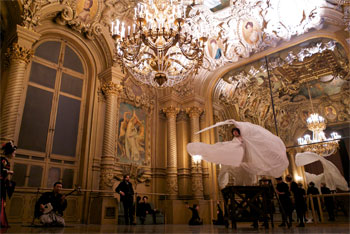 Question: He is also a highly ambiguous figure…
Question: He is also a highly ambiguous figure…
Stéphanie Di Giusto: We think he's going to hurt her where in fact he only does her good. He's an art lover. He is immediately taken with the artist he discovers on stage. He and Loïe share the same quest of the spirit and have a relationship that can't be qualified as friendship or love. There is no sexuality between them, and yet their relationship is full of sensuality. I like flirting with the idea of masculine impotence, a taboo subject in film. It was an impotence I felt like making sexy.
Question: All of the beauty of Loïe's moves comes from her expression and that of Gabrielle, played by Mélanie Thierry.
Stéphanie Di Giusto: Without them, Loïe doesn't exist, because there's no time to spend on her. I wanted her to be constantly moving forward.
Question: None of Loïe Fuller's performances were ever filmed. How were you able to recreate her show?
Stéphanie Di Giusto: That was the exciting challenge of the film. Despite the insistence of her friend Thomas Edison, Loïe Fuller always refused to immortalize her dance on film. 'It is out of the question that I be shut up in a box," she would say. The videos circulating on YouTube are only a pale copy of her imitators. Jodie Sperling, whom I mentioned earlier, helped a lot with the choreography. Given the lack of materials to go on, she was never able to reproduce Loïe Fuller's stage performances exactly, but she was touched that a film was being made using the same accessories and the same number of technicians. Even so, while respecting the period, the chief set designer Carlos Conti and I knew we'd need to use modern-day facilities, and we found artists with whom she would no doubt have worked had she still been alive, including Alexandre Le Brun, a true lighting artist whose work at the last Saint Laurent fashion shows blew me away. From there, we scrupulously followed Loïe Fuller's working methods. That took a lot of rehearsal time. And intensive training on the part of Soko.
Question: How did Soko prepare for the part?
Stéphanie Di Giusto: I wanted her to be muscular with a sturdy body. Soko worked six hours a day for a month with Jodie Sterling. The toughest part for her was keeping her balance while dancing 2.5 meters off the ground, in the dark. Soko is someone who gives 100% of herself. She's got a huge hunger for learning and she totally devoted herself to preparing. Four weeks later, she was ready. The challenge then was to make her forget the dance that Jodie Sperling had taught her. She needed to be able to give it her own interpretation. It was unthinkable for me to use a body double, we had to see it through.
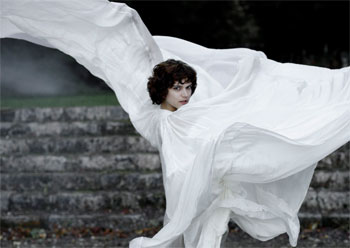 Question: Watching the film, we realize that every single show was a physical challenge…
Question: Watching the film, we realize that every single show was a physical challenge…
Stéphanie Di Giusto: It required a huge effort to coordinate the weightless movement. It's not just the arms that work, it's the whole body. As it happened, Loïe Fuller used to collapse after almost every show, like the scene at the Folies Bergère, where we see the heroine on a stretcher. Loïe only danced every three days. She needed to recuperate after every performance.
Question: The more she dances, the more she uses herself up. On top of the physical effort, the stage lights damage her eyes. And she constantly works out on a machine to strengthen her arm muscles.
Stéphanie Di Giusto: Every time Loïe enters the stage, it's like entering the ring. I drew a lot of inspiration for the film from boxing. I didn't film a dancer, I filmed a fighter. Even the way she collapses onto her seat at the end of a performance comes from boxing.
Question: It makes the comparison with Isadora Duncan all the more painful.
Stéphanie Di Giusto: Isadora is talented and she'd rather go drink cocktails with journalists than do bar work for hours. Her concept of dance differs radically from Loïe Fuller's: don't practice, dream, breathe deep, look at pictures of Greece for inspiration. When Loïe meets and falls in love with her, she falls first and foremost in love with a projection of herself, of that which she would love to have been and especially, that which she can never be.
Question: We sense a sort of self-destruction and self-disdain about her…
Stéphanie Di Giusto: Yes, she won't look at herself, she doesn't like herself, so she doesn't give herself a break. In this sense, The Dancer is also a film about self-esteem. I'm fascinated by the gap between the icon of femininity that she represents when she dances and the ordinary girl she returns to"and hates"in everyday life. Loïe is fully aware that without her costume, she no longer exists, and she does whatever it takes to not destroy the dream she offers her audience and the critics alike. She's afraid to disappoint, and she's right to be. Mallarmé, for instance, wrote sublime accounts of her performance, and was sorely disappointed when he met her.
And yet, she doesn't care about notoriety. In the end she's only happy when she's surrounded by people she works with or during showdowns with her technicians.
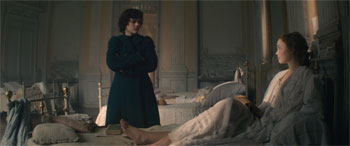 Question: In the film, she only dares to meet her audience once, at the Opera, oddly enough when they've seen her take a fall…
Question: In the film, she only dares to meet her audience once, at the Opera, oddly enough when they've seen her take a fall…
Stéphanie Di Giusto: At that point, she's already reached success. Thanks to Louis Dorsay, who helped her become a woman, and to Isadora Duncan, who provoked her in a telegram and pushed her to brave the stage of the Opera solo, she may at last like herself. It's Isadora who undresses her and has her accept her femininity.
Question: It's difficult in retrospect to grasp how famous she was at the time.
Stéphanie Di Giusto: Loïe Fuller was one of the world's best paid dancers. Yet, despite her having rallied both intellectuals and the general public, a lot of scholars don't consider her a dancer because she didn't pass on her knowledge. Knowing full well the inhumane, almost destructive side of her style, she taught the young girls she worked with to express something else. I had the chance to see a film she directed where her dancers are half-naked and incredibly free, which caused a scandal"it was 1900. But it was precisely this freedom that Loïe Fuller wanted to teach them.
In a final ironic twist of fate, she is buried in Père Lachaise, only a hundred meters from Isadora Duncan. Her tomb is overgrown whereas Isadora's is magnificently well kept. The injustice continues.
Question: There are some highly pictorial scenes in the film, like the death of her father with the blood flowing in the bathtub and the photo session where Loïe makes love for the first time in armor.
Stéphanie Di Giusto: For each scene, I tried to find an idea that would express a certain movement. And each time, I asked myself, have we seen it before? DP Benoît Debie contributed a lot to the pictorial quality of the film. He's the only one with this approach. Having seen his work on Gaspar Noé's Love, I knew he was the one I needed. Luckily, he loved the screenplay and agreed to work on the film. I'm like Loïe Fuller with her 25 technicians: without him, without Alain Attal, my producer, without Anaïs Roman, the costume supervisor, without Carlos Conti, set designer, without all of the people who worked with me, The Dancer wouldn't exist.
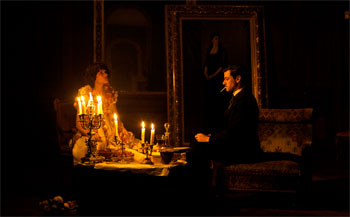 Question: Tell us about your own preparation.
Question: Tell us about your own preparation.
Stéphanie Di Giusto: I started location scouting even while I was writing. I needed to find the right settings to bring my characters to life, like the ruins in the park for Gabrielle's birthday dinner, the chateau's rotunda where she dances, the church where the Mothers live"which I found in Paris' 19th district, the theatre where she performs, and the Midwest scenes that we actually shot in the Vercors region of France. In the screenplay, there were details that took into account the places I'd chosen. I needed that to believe in it.
Question: Did you really shoot the last dance, the Dance of Mirrors, at the Paris Opera?
Stéphanie Di Giusto: Yes. But I only had one night, from 2:00 am to 8:00 am, to do it. That in itself was extraordinary.
Question: While she's already been in a few films, Lily-Rose Depp plays her first major role as Isadora Duncan in The Dancer.
Stéphanie Di Giusto: I'd never met her and I went to the States to do a screen test. From the very first scene, I knew I was dealing with a star. I was in awe. Lily-Rose, who is only 16, is afraid of nothing, and she is incredibly at ease in her body. While Soko had to train for weeks, Lily-Rose slipped right into character. Again, the same story of injustice.
Question: How do you direct actors as experienced as Soko, Mélanie Thierry, Gaspard Ulliel or François Damiens, who plays Marchand, the head of the Folies Bergère?
Stéphanie Di Giusto: I was like Loïe Fuller: I was on a mission. For me it wasn't Soko or Gaspard Ulliel walking through the door, it was Loïe Fuller and Louis Dorsay. I was so into my subject that I wasn't talking to actors but directly to the characters. They were all different: Soko, generous and committed, with an energy that just need channeling, Gaspard, a master of precision, Mélanie, talented and instinctive… It was hard for Mélanie Thierry to play a woman in the shadows. Given Loïe's overflowing energy, I need someone just as powerful but all in restraint. There's nothing harder to play than silence. It's a different kind of performance from Soko's, but just as difficult. I was really impressed by them all. I didn't do many takes and the actors sometimes worried. While respecting the period, my way of filming needed to be in line with my heroine's rhythm and energy, with her modernity. I like to film bodies in movement. It's something I stressed further during editing. I had the strange feeling that they were all there to support my film come what may. They all took risks. It's still a first feature; it was a gamble for them. I was really touched by their commitment.
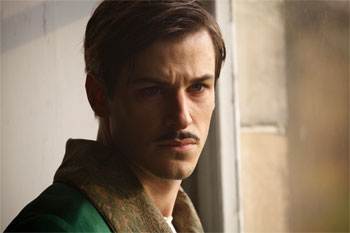 Question: A word about the music…
Question: A word about the music…
Stéphanie Di Giusto: Max Richter's highly contemporary take on Vivaldi was an immediate must for me in terms of the choreography. Loïe Fuller wasn't much of a music lover and she would dance to practically anything. To co-exist with Vivaldi, I chose the work of Warren Ellis and Nick Cave, who really move me.
Question: One can't help but see a connection between Loïe Fuller's struggle at every performance and that of a director shooting a first feature…
Stéphanie Di Giusto: All directors are Loïe Fullers. It's also, in a way, a film on the birth of cinema, since it's about movement and directing. Loïe Fuller embodies this art, which is elitist and popular at the same time. She sees the bigger, more beautiful picture. All art is a way of staying free. My film is about this vital liberty.
The Dancer
Release Date: September 28th, 2017
Trailer
www.palacefilms.com.au/thedancer/
MORE





